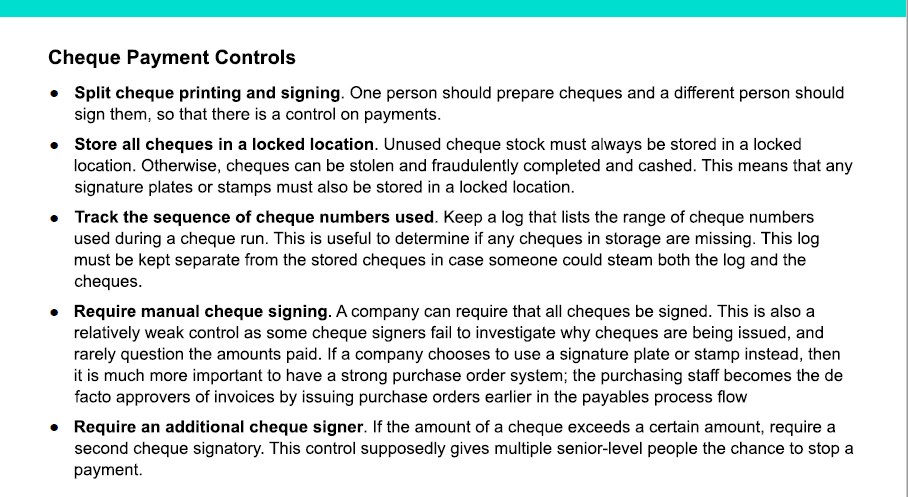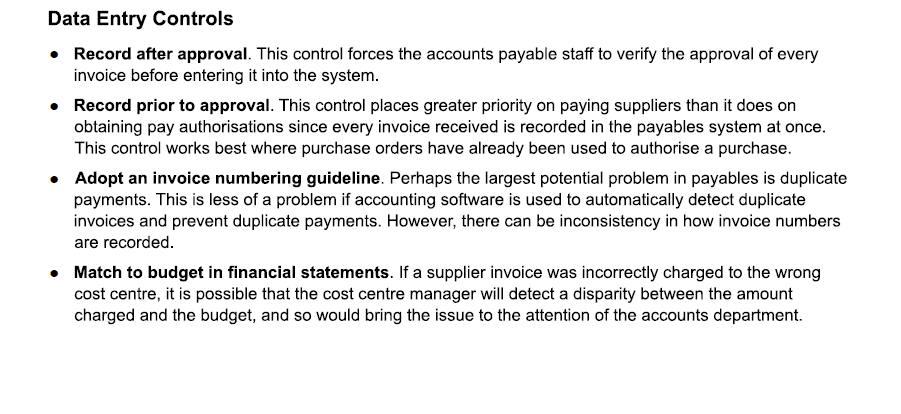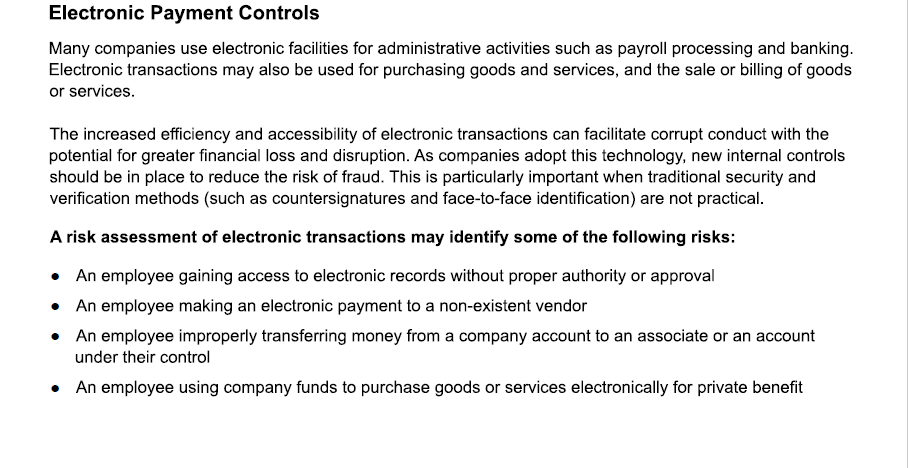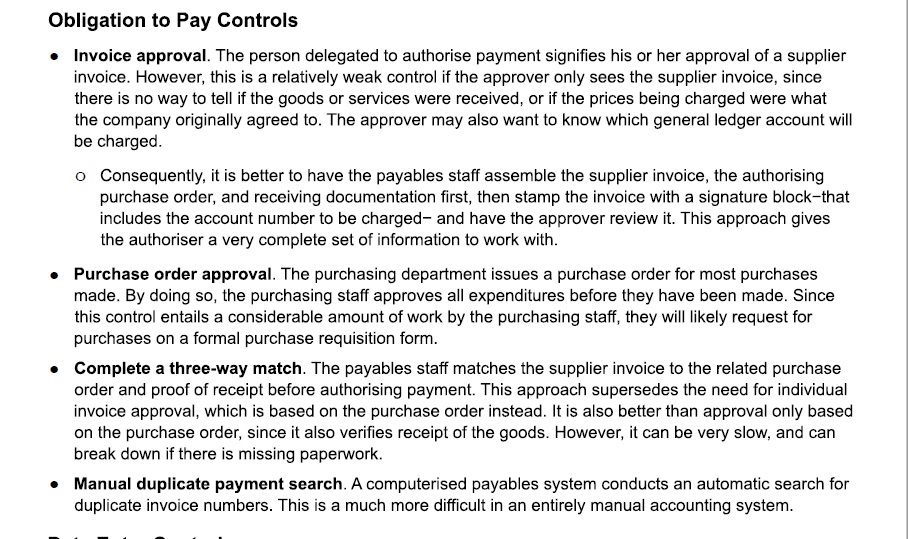Please answer the question using the provided references.
Provide a brief description of the options available in each accounts payable control category listed in the table below. Include any advantages and disadvantages of each control method.
a. Obligation to Pay
b. Data Entry Controls
c. Payment Controls
d. Electronic payment
Cheque Payment Controls . Split cheque printing and signing. One person should prepare cheques and a different person should sign them, so that there is a control on payments. a Store all cheques in a locked location. Unused cheque stock must always be stored in a locked location. Otherwise, cheques can be stolen and fraudulently completed and cashed. This means that any signature plates or stamps must also be stored in a locked location. a Track the sequence of cheque numbers used. Keep a log that lists the range of cheque numbers used during a cheque run. This is useful to determine if any cheques in storage are missing. This log must be kept separate from the stored cheques in case someone could steam both the log and the cheques. c Require manual cheque signing. Acompany can require that all cheques be signed. This is also a relatively weak control as some cheque signers fail to investigate why cheques are being issued. and rarer question the amounts paid. If a company chooses to use a signature plate or stamp instead, then it is much more important to have a strong purchase order system: the purchasing staff becomes the de facto approvers of invoices by issuing purchase orders eartier in the payables process ow . Require an additional cheque signer. If the amount of a cheque exceeds a certain amount. require a second cheque signatory. This control supposedly gives multiple senior-level people the chance to stop a payment. Data Entry Controls 0 Record after approval. This control forces the accounts payable staff to verify the approval of every invoice before entering it into the system. a Record prior to approval. This control places greater priority on paying suppliers than it does on obtaining pay authorisations since every invoice received is recorded in the payables system at once. This control works best where purchase orders have already been used to authorise a purchase. 0 Adopt an invoice numbering guideline. Perhaps the largest potential problem in payables is duplicate payments. This is less of a problem if accounting software is used to automatically detect duplicate invoices and prevent duplicate payments. However, there can be inconsistency in how invoice numbers are recorded. a Match to budget in nancial statements. If a supplier invoice was incorrectly charged to the wrong cost centre. it is possible that the cost centre manager will detect a disparity between the amount charged and the budget, and so would bring the issue to the attention of the accounts department. Electronic Payment Controls Many companies use electronic facilities for administrative activities such as payroll processing and banking. Electronic transactions may also be used for purchasing goods and services, and the sale or billing of goods or services. The increased efficiency and accessibility of electronic transactions can facilitate corrupt conduct with the potential for greater financial loss and disruption. As companies adopt this technology, new internal controls should be in place to reduce the risk of fraud. This is particularly important when traditional security and verification methods (such as countersignatures and face-to-face identification) are not practical. A risk assessment of electronic transactions may identify some of the following risks: . An employee gaining access to electronic records without proper authority or approval . An employee making an electronic payment to a non-existent vendor . An employee improperly transferring money from a company account to an associate or an account under their control . An employee using company funds to purchase goods or services electronically for private benefitObligation to Pay Controls Invoice approval. The person delegated to authorise payment signies his or her approval of a supplier invoice. However, this is a relatively weak control if the approver only sees the supplier invoice. since there is no way to tell if the goods or services were received, or if the prices being charged were what the company originally agreed to. The approver may also want to know which general ledger account will be charged. 0 Consequently, it is better to have the payables staff assemble the supplier invoice, the authorising purchase order, and receiving documentation rst, then stamp the invoice with a signature blockthat includes the account number to be charged- and have the approver review it. This approach gives the authoriser a very complete set of information to work with. Purchase order approval. The purchasing department issues a purchase order for most purchases made. By doing so, the purchasing staff approves all expenditures before they have been made. Since this control entails a considerable amount of work by the purchasing staff, they will likely request for purchases on a formal purchase requisition form. Complete a three-way match. The payables staff matches the supplier invoice to the related purchase order and proof of receipt before authorising payment. This approach supersedes the need for individual invoice approval, which is based on the purchase order instead. It is also better than approval only based on the purchase order, since it also veries receipt of the goods. However, it can be very slow, and can break down if there is missing paperwork. Manual duplicate payment search. A computerised payables system conducts an automatic search for duplicate invoice numbers. This is a much more difcult in an entirely manual accounting system










